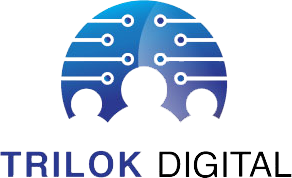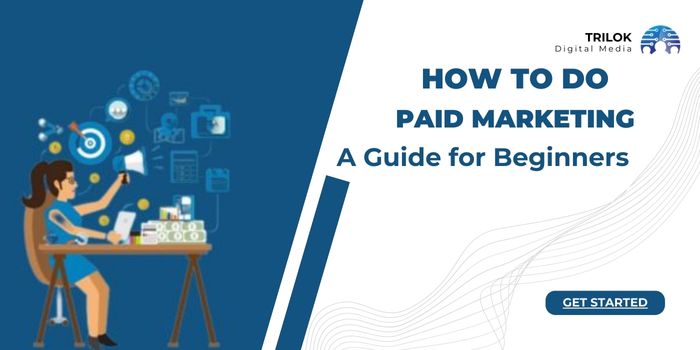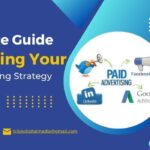Are you excited to boost your business and reach more people? Paid Marketing Guide for Beginners can be a great way to do just that! If you’re new to the world of paid marketing and feeling a bit overwhelmed, don’t worry.
In this beginner’s guide, we’ll walk you through the basics of how to do paid marketing in a simple and easy-to-understand way.
You’ll learn what paid marketing is, why it’s important, and some fundamental steps to get you started on the right foot. So, let’s dive in and explore the exciting realm of paid marketing together!
Paid marketing, also known as online advertising, is a strategic approach to promoting your products, services, or brand using paid online channels. It can be an effective way to reach a targeted audience and drive traffic, leads, and sales.
Here’s a beginner’s guide to getting started with paid marketing:
Set Clear Goals
Define what you want to achieve with your paid marketing campaigns. Common goals include increasing website traffic, generating leads, boosting sales, enhancing brand awareness, or promoting a specific event.
Understand Your Target Audience
Find out who your best customers are and make a pretend profile of them. Figure out things like how old they are, what they like, what they do on the internet, and what problems they have. This will help you make ads that they’ll really like.
Choose the Right Platforms
Select the online advertising platforms that align with your goals and target audience. Common options include:
Google Ads
For search and display ads that appear on Google search results and partner websites.
Facebook and Instagram Ads
These platforms offer extensive audience targeting options based on demographics, interests, and behaviors.
LinkedIn Ads
Suitable for B2B marketing, allowing you to target professionals by job title, industry, company size, etc.
Twitter Ads
Effective for real-time engagement and promoting trending topics.
YouTube Ads
Great for video content and reaching a broad audience.
Budgeting
Determine your advertising budget. Start small and gradually increase it as you gain insights and optimize your campaigns.
Keyword Research (if applicable)
If you’re using platforms like Google Ads, conduct keyword research to identify relevant keywords for your ads. These keywords will help your ads appear in relevant search results.
Create Compelling Ad Content
Make catchy titles, interesting words for your ads, and pictures that grab attention. Your ads should show why they’re good and make people want to do something about it.
Landing Pages
Ensure that the destination URLs you link to in your ads lead to well-designed, relevant landing pages. The landing pages should have a clear call to action (CTA) and be optimized for conversions.
Ad Formats
Different platforms offer various ad formats, including text ads, image ads, video ads, carousel ads, and more. Choose formats that resonate with your audience and suit your goals.
Audience Targeting
Utilize the targeting options available on each platform to reach the right people. This can include demographic targeting, interest targeting, and location targeting, and even retargeting users who have interacted with your website before.
Monitor and Optimize
Keep a close eye on how well your ads are doing. Look at things like how many people click on your ads, how many of those people actually do what you want (like buying something), how much it costs for each of those actions, and how much money you make from the ads.
A/B Testing
Test different ad variations to identify what works best. Experiment with different headlines, ad copy, visuals, and CTAs to refine your campaigns.
Remarketing
Implement remarketing campaigns to target users who have previously visited your website but didn’t convert. These campaigns can help you re-engage potential customers.
Adherence to Guidelines
Familiarize yourself with the advertising guidelines of each platform to ensure your ads are compliant and won’t be rejected.
Continuous Learning
Paid marketing is dynamic, and trends change over time. Stay updated with industry news, attend webinars, and read blogs to continue improving your skills.
Paid marketing requires experimentation and ongoing optimization. Start with a small budget, learn from your results, and refine your strategies over time for better outcomes.
What is Paid Marketing Guide for Beginners?
Paid Marketing Guide for Beginners:- Paid Marketing is also known as advertising, is a way that businesses promote their products or services using money. They pay to show their ads to people, usually on websites, social media, or search engines.
These ads can appear in different forms, like banners, videos, or text, and they aim to catch people’s attention and encourage them to buy or learn more about what the business is offering.
When a company does paid marketing, they choose who they want to see their ads based on factors like age, interests, and location. This helps them reach the right audience and increase the chances of getting more customers.
What are paid channels in marketing?
Paid marketing channels refer to various platforms and methods that businesses use to promote their products or services by paying for advertising space. These channels can help businesses reach a wider audience, increase brand visibility, and drive traffic to their websites or physical stores.
Here are some common Paid Marketing Guide for Beginners:
Google Ads (formerly Google AdWords)
Google Ads allows businesses to display ads on Google’s search engine results pages (SERPs) and across the Google Display Network. Ads can be text-based, display ads, video ads on YouTube, and more.
Social Media Advertising
We can put ads on places like Facebook, Instagram, Twitter, LinkedIn, and Pinterest. These ads can focus on certain groups of people, like those with specific ages or hobbies. This makes them really good at reaching the right people we want to talk to.
Display Advertising
This involves placing visual ads (such as banners, images, or videos) on websites and online platforms that are part of ad networks. Google Display Network and other third-party ad networks allow advertisers to target specific websites or audiences.
Native Advertising
Native ads blend in with the content of the platform they appear on, making them less intrusive and more engaging. They can be found on social media, news websites, and content discovery platforms.
Video Advertising
Apart from YouTube, video ads can be placed on social media platforms like Facebook, Instagram, and TikTok. Video ads are especially effective for conveying complex messages and engaging audiences.
Paid Search Advertising
This includes sponsored listings on search engines like Google, Bing, and Yahoo. Businesses bid on keywords relevant to their products or services to have their ads displayed when users search for those keywords.
Affiliate Marketing
While not traditional paid advertising, affiliate marketing involves partnering with individuals or other businesses who promote your products or services for a commission. Payment is based on performance, such as sales generated through the affiliate’s efforts.
Influencer Marketing
Collaborating with influencers who have a substantial following on social media platforms can help businesses reach their target audience through authentic and relatable content.
Retargeting or Remarketing
This involves showing ads to users who have previously visited your website but didn’t convert. It helps re-engage potential customers and encourages them to complete their desired action.
Email Marketing
While not always thought of as paid marketing, promoting products or services through email campaigns can involve costs related to email service providers and design.
Sponsored Content
This includes paying for articles, blog posts, or other forms of content on platforms with a large audience. It allows businesses to tap into existing readerships.
Shopping Feeds
E-commerce businesses mainly use these to list their products directly in search results, making it easier for users to discover and purchase items.
When choosing paid marketing channels, it’s important to consider your target audience, goals, budget, and the nature of your products or services.
A well-thought-out strategy that utilizes a mix of these channels can yield effective results in terms of brand exposure, lead generation, and sales.
What are the benefits of paid digital advertising?
Paid marketing, also known as advertising, offers several advantages for businesses. One big benefit is that it can quickly increase the visibility of a product or service.
Paying to advertise shows your content to a larger audience, which can lead to more people knowing about what you offer.
Paid marketing also allows you to target specific groups of people based on factors like their interests, demographics, and online behavior.
This means that you can target the right people who are more likely to be interested in what you’re selling. Additionally, paid marketing campaigns can provide measurable results, showing you exactly how many people saw your ad, clicked on it, or made a purchase.
This data helps Beginners to understand what’s working and what needs improvement, making your marketing efforts more effective over time.
Difference between organic and paid marketing
Organic and paid marketing are two distinct approaches to promoting your products, services, or brand. They involve different strategies, techniques, and costs.
Here’s a breakdown of the key differences between organic and paid marketing:
| Organic Marketing | Paid Marketing | |
| Definition | Organic marketing refers to the strategies and tactics used to naturally attract and engage an audience without directly paying for advertising space. | Paid marketing involves paying to display ads or sponsored content in various online spaces to reach a targeted audience. |
| Channels | Organic marketing typically takes place on platforms such as search engines (SEO), social media, content marketing, email marketing, and word-of-mouth referrals. | Paid marketing takes place on platforms such as search engines (Google Ads), social media (Facebook Ads, Instagram Ads), display networks, video platforms (YouTube Ads), and more. |
| Cost | The primary cost in organic marketing is time and effort spent on creating valuable content, optimizing for search engines, and building a loyal audience. | The cost in paid marketing involves the budget allocated for placing ads. You pay each time someone clicks on your ad (Pay-Per-Click) or based on impressions (Pay-Per-Impression). |
| Visibility | Organic marketing relies on appearing in search results or social media feeds based on the relevance and quality of your content. It can take time to build up visibility and credibility. | Paid marketing allows you to immediately reach a specific audience by placing ads at the top of search results or in prominent positions on social media platforms. |
| Control | Organic marketing often builds stronger trust and credibility with the audience since it’s seen as non-intrusive and based on providing value. | You have greater control over who sees your ads, when they’re shown, and the messaging you use. This enables precise targeting. |
What is the highest paying skill in digital marketing?
In the world of digital marketing, some skills can earn you more money than others. These high-paying skills are like special tools that help businesses succeed online.
One important skill is “data analysis.” This means understanding numbers and information to see what works and what doesn’t in online campaigns.
Another skill is “search engine optimization (SEO),” which helps websites show up higher on search results, bringing in more visitors. “Content strategy” is also valuable, involving creating interesting and useful things for people to read or watch online.
Lastly, “social media advertising” skill is important, as many businesses use social media to connect with customers. Learning these skills could lead to better job opportunities and higher pay in the digital marketing world.
Does paid traffic work for affiliate marketing?
Paid traffic for affiliate marketing involves paying for advertisements to attract visitors to a website or a product that you’re promoting as an affiliate. Instead of relying solely on organic methods like search engine optimization, paid traffic allows you to reach a larger audience more quickly.
When utilizing paid traffic, you create ads that display on platforms such as search engines, social media, or other websites. When people click on your ads and visit the website you’re promoting, and if they make a purchase or complete a desired action, you earn a commission.
It’s important to choose the right keywords, target the right audience, and create compelling ads to make the most out of your investment in paid traffic for affiliate marketing.
Paid digital marketing examples
Trilok Digital Media is a fantastic aid in the world of paid digital marketing. Imagine you have a shop, but it’s on the internet. Trilok Digital Media helps you put up ads on popular websites and social media platforms, so when people are scrolling through their favorite sites or checking out their friends’ posts, they might see your ads and become interested in what you offer.
It’s like hanging a big sign outside your online shop, but in a virtual space. This helps you reach out to the right people who might really want to buy your products or use your services.
Just like how a shopkeeper puts up posters to attract customers, Trilok Digital Media puts your ads where potential customers are likely to see them.
It’s okay to start small and gradually expand your efforts as you become more comfortable. Keep experimenting, learning from your results, and adjusting your strategies accordingly.
Paid marketing can be a powerful tool to help your business grow, and with dedication and continuous learning, you can master it. Best of luck on your paid marketing journey!




